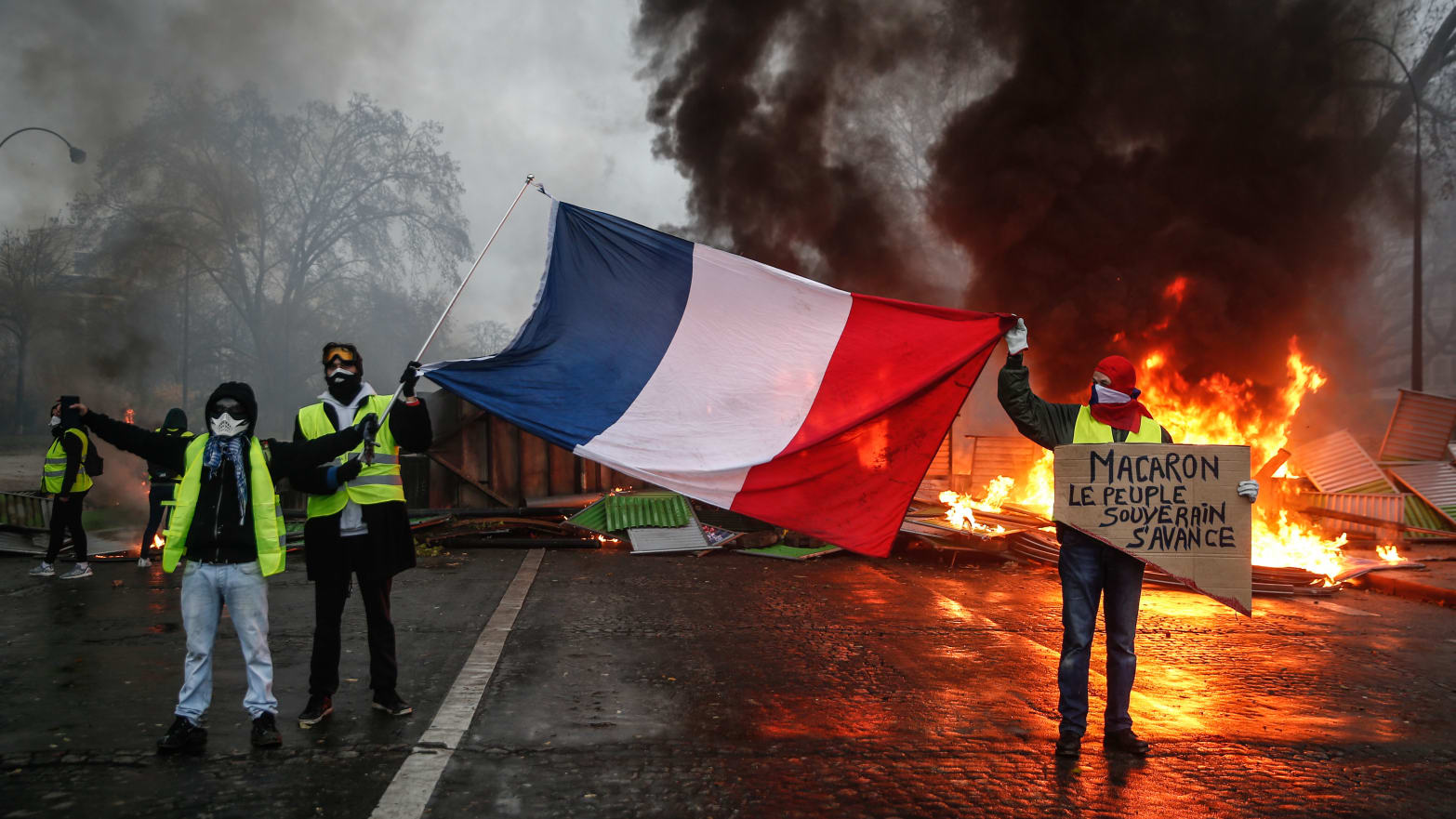PARIS—The little girl in the designer parka walking with her parents toward the Arc de Triomphe was indignant Sunday morning. She looked at the burned-out cars on the Avenue Kléber and the spider-web patterns of half-shattered glass on the windows of shops, hotels and offices in their affluent neighborhood. “C’est la catastrophe!” she shouted—“It’s a catastrophe!”—with all the conviction of the child in the fairy tale who announced to the world that the emperor had no clothes.
The third weekend of nationwide protests and the second Saturday of increasingly violent confrontations with police have indeed startled the nation, but they may be even more shocking to a global audience for whom French President Emmanuel Macron has become an icon of reason and prudence in opposition to Donald Trump’s global politics of belligerency and emotion.
When Macron was heard over an open mic at the G20 confronting Saudi Crown Prince Mohammed bin Salman, allegedly the mastermind of Washington Post contributor Jamal Khashoggi’s grisly murder, he was given kudos in the press for warning MBS, “You never listen to me.”
But a year-and-a-half after Macron took office, a majority of the French are trying to tell him, “You don’t listen to us!” His approval ratings are abysmal (as Trump likes to point out), and the rioting in Paris underscores the discontent. But it also makes it much, much harder for Macron to find a solution to the demands of the unhappy but peaceful majority.
“La catastrophe” has been so extreme and shocking these last two weekends that any flexibility on Macron’s part will be seen as capitulation to violence.
The vandalism in Paris was the work of small, violent gangs, some of whom pretend to left-wing ideologies, others to right-wing thinking, and many of whom just like to trash things for the fuck of it.
“Casseurs,” they’re called: those who break things. And they often can be found at the tail end of big demonstrations here—or even celebrations. Some buildings on the Champs Élysées were more badly damaged during the World Cup victory parade last summer than they were in these recent protests.
But, then, these protests are not like the ones we—or the government—are used to seeing.
They are largely leaderless, organized more or less spontaneously on Facebook and united by the wearing of bright yellow vests, or gilets jaunes, that every car in France is required to carry so that anyone stopped by the road fixing a flat tire or making other repairs can be seen easily.
The basic issue is a combination of rising fuel prices and new, rising taxes on top of those, which are designed to help France make some of the reductions of greenhouse gases that the Paris Climate Accord calls for (and which Trump rejected). Most of the French are in complete agreement with the objective; they just don’t want to pay for it. And the rising costs put a huge burden on people who cannot afford to live in Paris or the many other beautiful old cities of France. Many of them must drive long distances before they even reach the commuter train networks.
Much like the main streets of American small towns, the quaint villages in this country have been dying as shopping centers and “hypermarkets” pull commerce away from them. Public services are being stripped away as well, with longer and longer drives to hospitals a particular problem. So the impression given by the government in the French capital is that it’s demanding these people pay more for clean air … in the French capital.
It was no accident that much of the vandalism was pointed at symbols of Parisian affluence and power. Graffiti was sprayed on the Arc de Triomphe (one example: “Gilets jaune = Antifa”), at least one bank office was burned, a mansion full of lawyers’ offices looking out on the Arc was set ablaze, and cars in the heart of Paris were ignited with the same reckless abandon seen in the outer suburbs in 2005.
Back then, people outside France kept asking, “Is Paris burning.” On Saturday some small parts of it certainly were.
As shocked as many were by the vandals, the reaction of the police was pretty dramatic as well, blockading streets and launching countless teargas grenades. The acrid clouds drifted over the city center as the police tried to push back against the casseurs chiseling paving stones out of the streets and throwing them at the cops.
There are different intensities of gas available to police, and this was some of the mildest. But on Sunday morning, as the cleanup crews got to work sandblasting the graffiti off the Arc de Triomphe, tear gas canisters littered the streets like Solo cups after a fraternity party.
Some basic numbers illustrate the reasons for the discontent:
The price of diesel, the most commonly used fuel in French cars, has reached its highest point in 15 years, and has risen over 23 percent over the past year alone to an average of €1.51. That works out to roughly $6.50 a gallon. In addition, Macron’s government raised its hydrocarbon tax this year by 7.6 centimes per liter on diesel and 3.9 centimes on gasoline, as part of an environmental campaign for cleaner cars and fuel.
The decision to impose a further increase of 6.5 centimes on diesel and 2.9 centimes on gasoline on January 1 of next year further fueled anger against both the price hike, and against Macron himself, criticized for being “a president for the rich” who is out of touch with everyday French people.
The first gilets jaunes protest occurred on November 17, during which protesters erected about 2,000 roadblocks throughout France. The actual number of demonstrators nationwide has been declining, but the violence in Paris has been increasing. Some 136,000 people demonstrated throughout France on Saturday (down from 166,000 the previous week).
According to the latest figures released by the Ministry of the Interior on Sunday (as reported by Radio France International) 263 people were injured in Saturday’s violence, including 23 members of the security forces, while 378 people were taken into police custody.
Authorities have estimated that between 1,000 and 1,500 casseurs were behind Saturday’s outbreak of violence, and some of them used disruptive tactics typical of the so-called Black Blocs and Antifa groups. But Johanna Primevert, the spokesperson for the Paris Police Prefecture, said it was too early to determine an exact profile of those arrested.
“We have noticed more and more groups that are very determined to spread out around Paris and cause trouble,” she told BFMTV.
In an interview with Europe1, government spokesman Benjamin Griveaux said that all options were being considered in light of Saturday’s violence, including imposing a state of emergency in the country.
“We must think about the measures we can take to avoid this kind of serious demonstration of violence on public thoroughfares from happening again in Paris,” he said.
Meanwhile, images of vandalism and vehicles set alight near popular hotspots such as the Champs-Élysées and the Ritz on Place Vendôme have raised fears in the hearts of French tourism authorities, who note that such scenes of lawlessness, especially during the busy holiday season, could be devastating to the industry.
“The protests yesterday massacred the welcoming image of Paris and of France, “Roland Héguy, president of the Confédération des Acteurs du Tourisme, told BFMTV. “I consider the Christmas holidays compromised, even ruined.”
“These intolerable images of rioting,” he said, “are not only going to discourage foreign tourists, because they are shocking and worrying, but also French [visitors] who are going to go back home. These Saturday demonstrations have to stop, and stop quickly.”
That may not happen for a while. Sunday was calm, but nobody knows things will look like a week from now.
Near Place du Trocadero overlooking the Eiffel Tower on Sunday, a news vendor manning his kiosque described for us the way the casseurs had swept past him and up Avenue Kléber, trashing just about anything and everything that caught their eye.
“They missed you,” we said.
“Maybe next Saturday,” he said.


